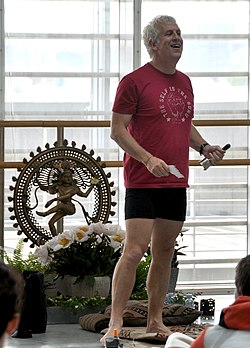
John Friend (born May 30, 1959), [1] born Clifford Friend, [2] is an American yoga guru and creator of Anusara Yoga. [3]

John Friend (born May 30, 1959), [1] born Clifford Friend, [2] is an American yoga guru and creator of Anusara Yoga. [3]
Friend first learned of yoga at the age of 8 in Youngstown, Ohio, when his mother, Ann Friend, read him stories of yogis with hidden knowledge and supernatural powers. By age 13, he began studying yoga philosophy with the Bhagavad Gita and Upanishads, and also began an asana practice by following Swami Satchidananda's book Integral Hatha Yoga.
At 17, Friend began a regular practice of sitting meditation with a Sufi group as well as members of the Theosophical Society. At age 19 he moved to Houston, Texas, where he studied various styles of hatha yoga including Ananda Yoga, Sivananda Yoga, and Kundalini Yoga. He also began teaching yoga part-time while working as a financial analyst.
In 1984, Friend began practicing the Ashtanga (vinyasa) yoga Primary Series and, in 1986, quit his analyst job to teach yoga full-time. In 1987, Friend graduated to Secondary Series while studying with Ashtanga founder K. Pattabhi Jois in California where he also studied with Iyengar Yoga teacher Judith Lasater. That same year, Friend attended an Iyengar Yoga convention in Boston, where he met B.K.S. Iyengar, after which Friend focused his studies and practice mainly in Iyengar Yoga. Between 1990 and 1995, John earned Iyengar's Introductory and Junior Intermediate teaching certificates and also served on the Board of Directors for the Iyengar Yoga National Association before departing in 1997 to found Anusara Yoga. [1] [4]
Friend set up Anusara as a style of hatha yoga founded on a Tantric philosophy of intrinsic goodness and based on bio mechanical principles of alignment. Friend derived the name Anusara as meaning 'flowing with Grace,' 'flowing with Nature' and 'following your heart,'" as interpreted from the Sanskrit anusāra, meaning "custom, usage, natural state or condition". Founded on Iyengar's system of alignment, Friend streamlined everything into five "Universal Principles of Alignment", which corresponded to other quinary aspects of the world, such as the five elements, five regular polygons, five fingers on the hand, and so on. Friend also developed refinements to his quinary system, which included what he called "the Three A's of Anusara" (attitude, alignment and action), seven energy loops that comprise the human body, and various cues to assist in teaching.
Anusara's philosophical system drew from Friend's knowledge in Indian schools of thought, including Samkhya, Advaita Vedanta, Vajrayana Buddhism, and non-dual Hindu Tantric schools, particularly non-dual Shaivism, which he refers to as Shiva-Shakti Tantra. Friend also incorporates his other studies, such as Taoism, Sufism, Kabbalah, Theosophy, Wicca, quantum physics, sacred geometry, and western psychology. [5]
In February 2012, an anonymous tipster published accusations on jfexposed.com (short for "John Friend exposed"), which later appeared on the blog YogaDork. [6] These allegations of mismanagement and abuse were later reported on at length in an article in The Washington Post . [7] The four key accusations against Friend were:
Friend announced in March 2012 that he would step down from the leadership, while retaining the sole ownership, of Anusara Yoga to take a short leave of absence to consider his next steps in the yoga community. [12]
In 2013, John Friend began working with Colorado-based yoga teaching sisters Desi and Micah Springer to help systematize a yoga methodology they had developed. Prior to this, Friend had been dating Desi Springer. [13] Originally called "The Roots" practice, [14] the yoga system was rebranded in 2013 as Sridaiva (श्रीदैव, Sanskrit for "divine destiny") [13] as coupled with an alignment methodology called Bowspring. [15] Friend teaches the Bowspring method at Vital Yoga Studio as well as on international teaching tours with Springer. [16]